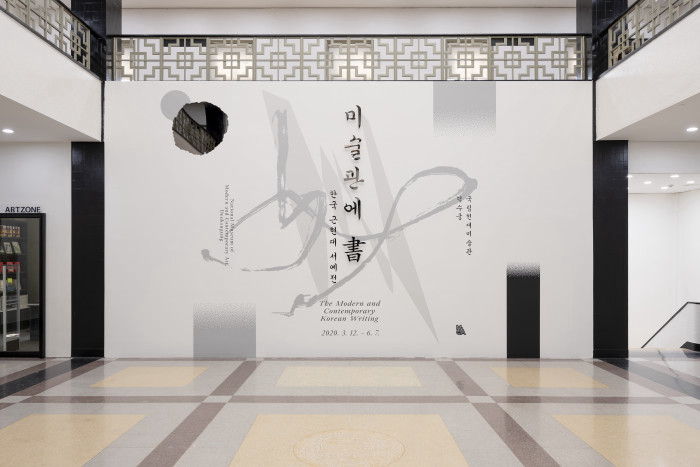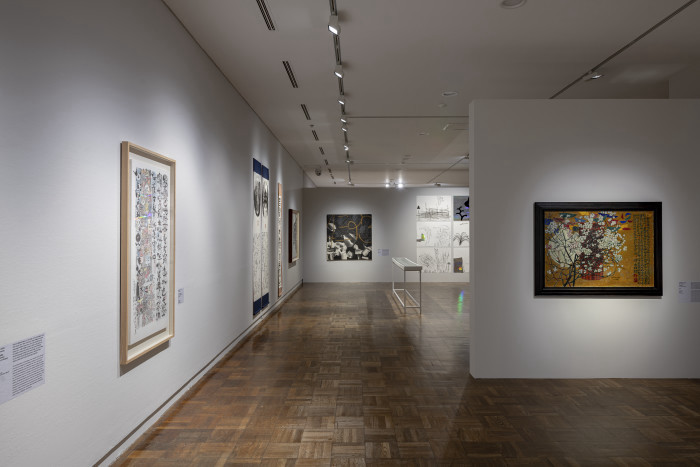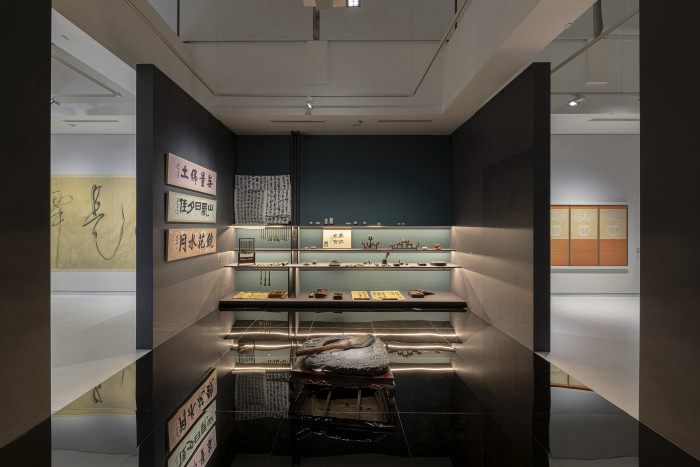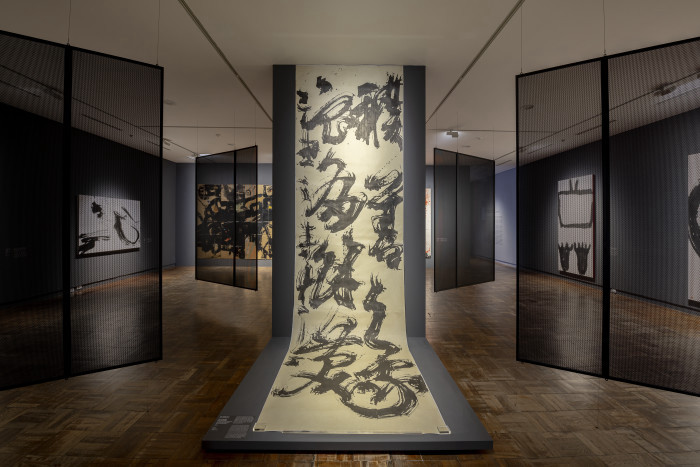>
Opened on-Line
An Independent Temporary Exhibition opened, of Calligraphy - for the first time in the National Museum of Modern and Contemporary Art
◇ Independent Temporary Exhibition of Calligraphy for the first time at the National Museum of Modern and Contemporary Art.
- Capturing at once the Flow and Development Process of the Korean Calligraphy in the Modern and Contemporary Ages.
- A total of some 300 works and some 70 items: Calligraphy, Seal Engraving, Painting, Pottery, Sculpture, Media Art, and so on.
◇For the first time, the work of the first generation of modern and contemporary calligraphers who actively worked after the Liberation.
- Including major works ranging from Artist Sojeon Son Jae-Hyung to 12 artists of the first generation at the National Art Exhibition.
- Releasing, for the first time, some 10 collections of the artists Galmul Lee Cheol Gyeong, Pyeongbo Seo Hee-hwan, Geomyeo Yoo Hee kang, and more.
◇ Pre-releasing a new opening exhibition on-line, for the first time in history.
- Curator Exhibition Tour for over 90 minutes, recorded and broadcasted at 4:00 pm on Mar. 30, 2020 (Monday).
National Museum of Modern and Contemporary Art (MMCA, Director: Youn Bum-mo) will pre-release, through its YouTube Channel (youtube.com/MMCA Korea) at 4:00 pm on Mar. 30, 2020 (Monday), the video , the first independent temporary exhibition of calligraphy since this art museum opened, and this years’ first new exhibition.
aims to consider the role and meaning of calligraphy in modern and contemporary Korean art. This exhibition shows how ‘calligraphy’, handed down from the traditional times, endured many stages before modernity being parts of a wide ranges of art exhibitions and national art exhibitions. Specifically, multiple historical lines in calligraphy are to be considered collectively: contemporary calligraphy and design calligraphy emerged in the pre- and post-2000s, including the works of 12 modern and contemporary calligraphers of the first generation after Korean liberation. The relations between calligraphy and any other art genres help convey the purpose of the exhibition. Some 300 collected works, including calligraphy, seal engraving, painting, sculpture, pottery, media art, printing media, and some 70 items in the exhibition hall.
This exhibition includes the following four subjects: ‘Drawing Calligraphy and Writing Pictures’, ‘Writing Means the Man: Modern and Contemporary Korean Calligraphers of the First Generation’, ‘Calligraphy Again: Experiment and Exception’, and ‘Wearing Design and Embracing the Daily Life’.
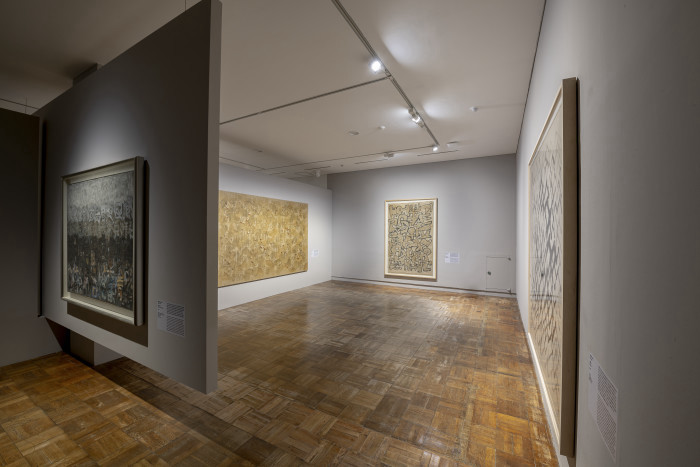
Part I “Drawing Calligraphy and Writing Pictures” investigates the influences of calligraphy on other genres, such as painting and sculpture, to clarify why ‘calligraphy’ is considered art, and indicate why calligraphy is an art form of its own. Part I is divided into three sub-subjects to find out the relationship between contemporary art and calligraphy. First, shows how modern and contemporary artists who conform to the traditional concepts of uniformity in illustrated poems, in Sinmuminhwa (literary painting), leading to illustrated poems. Second, investigates how calligraphy structures and norms-based letter elements are presented. Lastly, reveals how properties of materials such as quality, duration, speed, rhythm and energy that writing brush of calligraphy has would be expressed and reflected in real works.
Part II “Writing Means the Man: Modern and Contemporary Korean Calligraphers of the First Generation” investigates the modern history, turning points and changing patterns of calligraphy appearing in Korean traditional calligraphy in the post-modern age, with the main focus on the work of 12 modern and contemporary Korean calligraphers of the first generation. The 12 artists well-known as the figures representing modern and contemporary Korean calligraphy were well-versed in writing the five Sino-Chinese characters (Jeon: 篆•Ye隷: Hae楷: Haeng行•Cho: 草). Those artists showed leadership in ‘modernizing calligraphy’, throughout the turbulent times during the period of the Japanese occupation and liberation, to establish their artistic visions. These artists used to embody their specific visions in their calligraphy, reflecting the events they had experienced during their lives. Through such work, it is understood that writing “means nothing other than the man”.
Part III “Calligraphy Again: Experiment and Exception” investigates novel creation and experiment in contemporary calligraphy through the works of the artists of the second generation, those that were trained in calligraphy by artists of the first generation, and who participated in the National Art Exhibition. This part questions of the extension and artistic value of calligraphy in contemporary calligraphy circles when diversity and individualization of calligraphy emerged, with a focus on “Calligraphy Again.” The feature of this exhibition is the artists and work selected according to three criteria of the selection committee of 15 members: ‘The Succession and Reinterpretation of Tradition’, ‘Novel Creation and Exception of Calligraphy’, and ‘Artistic Value of Calligraphy of the Korean Alphabet.’ Contemporary calligraphy focuses on the image of calligraphy rather than the details of sentence or legibility of writing, thus, putting heavier weight on ‘scanning calligraphy’, not ‘reading calligraphy’, in contrast to traditional calligraphy, emphasizing the unity of the sentence and calligraphy. These developments mirror the flow of today’s contemporary art and show calligraphy as a pure art, communicating and integrating with other genres.
Part IV “Wearing Design and Embracing the Daily Life” shows the potential for multiple extensions of calligraphy design, with the focus on calligraphy culture in daily life, and writing in contemporary society. Calligraphy and typography in harmony with practicality and artistic value are commercialized. The former refers to an understanding of calligraphy as a ‘sentimental visual art embodying handwriting’ to the public, and the latter refers to writing that heightens legibility or is embellished with neat design. In this context, the selected works suggest a great deal of roles, category and potential uses for calligraphy.
The Curator Exhibition Tour will be broadcasted for some 90 minutes, at 4:00 pm on Mar. 30, 2020 (Monday) through YouTube, with Arts and Sciences Curator Bae Won-jeong in charge of planning the exhibition, and who will explain the program.
The Director of the National Museum of Modern and Contemporary Art, Youn Bum-mo, said, “This exhibition has been prepared with the determination to open a chapter in the calligraphy textbook. Korean calligraphy that highly appreciates artistic value, unlike Chinese and Japanese calligraphy, which is considered to present the development of a splendid, new age of letter art.” He added, “Although spectators cannot personally visit the art museum, owing to the impact of COVID-19, they can see the calligraphy exhibition through on-line broadcasting, reaching out to all people.”
The National Museum of Modern and Contemporary Art is temporarily closed until Apr. 05, 2020 (Sunday). The reopening date depends on the public needs regarding the COVID-19 virus situation, and a public announcement will be made.
□ For Enquiries: +82-02-2022-0600 (Representative Number of the Deoksugung Palace of National Museum of Modern and Contemporary Art)
■ Overview of Exhibition
○ Subject of Exhibition: The Korean Letter 《미술관에 書: 한국 근현대 서예전》
The English Letter: The Modern and Contemporary Korean Writing
○ Period of Exhibition: April~ July in 2020 (The period may be adjusted, depending on the public needs regarding the COVID-19 virus situation)
○ Place of Exhibition: Gallery of Deoksugung Palace of National Museum of Modern and Contemporary Art (2nd, 3rd floors)
○ Artists: Gang Byeong-in, Go Bong-ju, Gwon Chang-ryun, Kim Gyu-jin, Kim Gi-seung, Kim Gi-chang, Kim Don-hui, Kim Yong-jun, Kim Eung-hyeon, Kim Jong-geon, Kim Jong-yeong, Kim Chang-yeol, Kim Chung-hyeon, Kim Tae-seok, Kim Hwan-gi, Nam-gwan, Park Dae-seong, Park Won-gyu, Pae Gil-gi, Seo Byeong-oh, Seo Se-ok, Seo Hui-hwan, Seok Do-ryun, Son Jae-Hyung, Song Seong-yong, An Sang-su, Yeo Tae-myeong, Oh Se-chang, Oh Su-hwan, Yoo Hee kang, Lee Gang-so, Lee Gi-wu, Lee Dong-heung, Lee Sang-hyeon, Lee Wu-hwan, Lee Eung-ro, Lee Il-gu, Lee Cheol Gyeong, Lee Han-bok, Jang Wu-seong, Jeong Jin-yeol, Choe Man-rin, Choe Min-ryeol, Hyeon Jung-hwa, Ha Seung-yeon, Hwang Seok-bong, Hwang In-gi, Hwang Chang-bae (a total of 48 people, Arranging the name according to Romanization).
○ Exhibition Works / Data: some 300 collected works and some 70 items: Calligraphy, Seal Engravings, Paintings, Pottery, Sculpture, Media Art
○ Admission Fee: 3,000 won
○ Led by: National Museum of Modern and Contemporary Art
|
<ggc의 모든 콘텐츠는 저작권법의 보호를 받습니다.>
